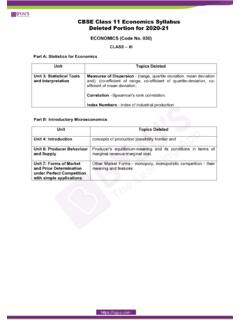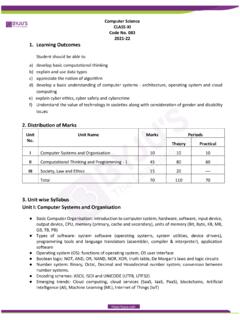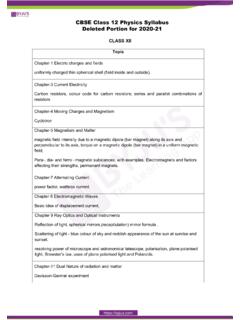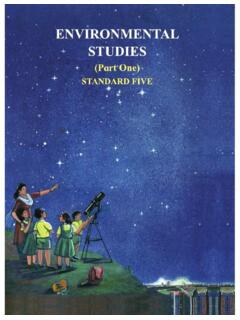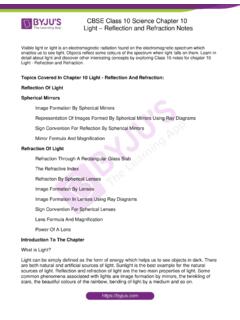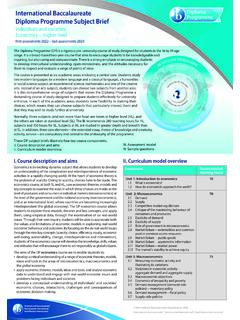Transcription of CBSE Class 10 Social Science Term Wise Syllabus 2021-22
1 11 COURSE STRUCTURE Class X ( 2021-22 ) TERM - I M. MARKS: 40No. Units No. of Periods Marks I India and the Contemporary World -1 12 10 II Contemporary India I 16 10 III Democratic Politics I 14 10 IV Economics 20 10 Total 62 40 TERM- II M. MARKS: 40No. Units No. of Periods Marks I India and the Contemporary World -1 34 10 II Contemporary India I 19 10 III Democratic Politics I 14 10 IV Economics 22 10 Total 89 40 COURSE CONTENT - X TERM - IUnit 1: India and the Contemporary World II Themes Learning Objectives Section 1: Events and Processes 1. The Rise of Nationalism in Europe The French Revolution and the Idea ofthe Nation The Making of Nationalism in Europe The Age of Revolutions: 1830-1848 The Making of Germany and Italy Visualizing the Nation Nationalism and Imperialism Enable the learners to identify andcomprehend the forms in whichnationalism developed along with theformation of nation states in Europe inthe post-1830 period.
2 Establish the relationship and bring outthe difference between Europeannationalism and anti-colonialnationalisms. Understand the way the idea ofnationalism emerged and led to theformation of nation states in Europe Class 10 Social Science Term Wise Syllabus 2021-2212 unit 2: Contemporary India II Themes Learning Objectives 1. Resources and Development Types of Resources Development of Resources Resource Planning in India Land Resources Land Utilization Land Use Pattern in India Land Degradation and Conservation Measures Soil as a Resource Classification of Soils Soil Erosion and Soil Conservation 3. Water Resources Water Scarcity and The Need for Water Conservation and Management Multi-Purpose River Projects and Integrated Water Resources Management Rainwater Harvesting Note: The theoretical aspect of chapter Water Resources to be assessed in the Periodic Tests only and will not be evaluated in Board Examination.
3 However, the map items of this chapter as listed will be evaluated in Board Examination. 4. Agriculture Types of farming Cropping Pattern Major Crops Technological and Institutional Reforms Impact of Globalization on Agriculture Understand the value of resources and the need for their judicious utilization and conservation. Comprehend the importance of water as a resource as well as develop awareness towards its judicious use and conservation. Identify different Dams in the country. Explain the importance of agriculture in national economy. Identify various types of farming and discuss the various farming methods; describe the spatial distribution of major crops as well as understand the relationship between rainfall regimes and cropping pattern.
4 Explain various government policies for institutional as well as technological reforms since independence. 13 unit 3: Democratic Politics II Themes Learning Objectives 1. Power Sharing Case Studies of Belgium and Sri Lanka Why power sharing is desirable? Forms of Power Sharing 2. Federalism What is Federalism? What make India a Federal Country? How is Federalism practiced? Decentralization in India Familiarize with the centrality of power sharing in a democracy. Understand the working of spatial and Social power sharing mechanisms. Analyse federal provisions and institutions. Explain decentralization in rural and urban areas. unit 4: Economics Themes Learning Objectives 1.
5 Development What Development Promises - Different people different goals Income and other goals National Development How to compare different countries or states? Income and other criteria Public Facilities Sustainability of development 2. Sectors of the Indian Economy Sectors of economic Activities Comparing the three sectors Primary, Secondary and Tertiary Sectors in India Division of sectors as organized and unorganized Sectors in terms of ownership: Public and Private Sectors Familiarize with concepts of macroeconomics. Understand the rationale for overall human development in our country, which includes the rise of income, improvements in health and education rather than income. Understand the importance of quality of life and sustainable development.
6 Identify major employment generating sectors. Reason out the government investment in different sectors of economy. 14 LIST OF MAP ITEMS Class X ( 2021-22 ) TERM I ---------------------------------------- ---------------------------------------- ----------------------------------- A. GEOGRAPHY Chapter 1: Resources and Development a. Major soil Types Chapter 3: Water Resources Dams: a. Salal b. Bhakra Nangal c. Tehri d. Rana Pratap Sagar e. Sardar Sarovar f. Hirakud g. Nagarjuna Sagar h. Tungabhadra Note: The theoretical aspect of chapter Water Resources to be assessed in the Periodic Tests only and will not be evaluated in Board Examination. However, the map items of this chapter as listed above will be evaluated in Board Examination. Chapter 4: Agriculture a. Major areas of Rice and Wheat b.
7 Largest / Major producer States of Sugarcane, Tea, Coffee, Rubber, Cotton and Jute 15 COURSE CONTENT X TERM - II unit 1: India and the Contemporary World II Themes Learning Objectives Section 1: Events and Processes 2. Nationalism in India The First World War, Khilafat and Non - Cooperation Differing Strands within the Movement Towards Civil Disobedience The Sense of Collective Belonging Section 2: Livelihoods, Economies and Societies Note: Any one theme of the following. The theme selected should be assessed in the periodic test only and will not be evaluated in the board examination: 3. The Making of a Global World The Pre-modern world The Nineteenth Century (1815-1914) The Inter war Economy Rebuilding a World Economy: The Post-War Era 4.
8 The Age of Industrialization Before the Industrial Revolution Hand Labour and Steam Power Industrialization in the colonies Factories Come Up The Peculiarities of Industrial Growth Market for Goods Recognize the characteristics of Indian nationalism through a case study of Non-Cooperation and Civil Disobedience Movement. Analyze the nature of the diverse Social movements of the time. Familiarize with the writings and ideals of different political groups and individuals. Appreciate the ideas promoting Pan Indian belongingness. Show that globalization has a long history and point to the shifts within the process. Analyze the implication of globalization for local economies. Discuss how globalization is experienced differently by different Social groups.
9 Familiarize with the Pro- to-Industrial phase and Early factory system. Familiarize with the process of industrialization and its impact on labour Class . Enable them to understand industrialization in the colonies with reference to Textile industries. 16 unit 2: Contemporary India II Themes Learning Objectives 5. Minerals and Energy Resources What is a mineral? Mode of occurrence of Minerals Ferrous and Non-Ferrous Minerals Non-Metallic Minerals Rock Minerals Conservation of Minerals Energy Resources o Conventional and Non-Conventional Conservation of Energy Resources Note: The theoretical aspect of chapter Minerals and Energy Resources to be assessed in the Periodic Tests only and will not be evaluated in Board Examination.
10 However, the map items of this chapter as given in the Map List will be evaluated in Board Examination 6. Manufacturing Industries Importance of manufacturing Contribution of Industry to National Economy Industrial Location Classification of Industries Spatial distribution Industrial pollution and environmental degradation Control of Environmental Degradation 7. Life Lines of National Economy Transport Roadways, Railways, Pipelines, Waterways, Airways Communication International Trade Tourism as a Trade Identify different types of minerals and energy resources and places of their availability Feel the need for their judicious utilization Bring out the importance of industries in the national economy as well as understand the regional disparities which resulted due to concentration of industries in some areas.
